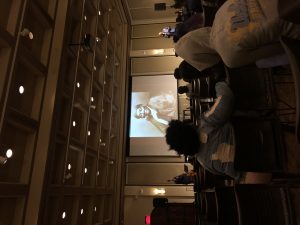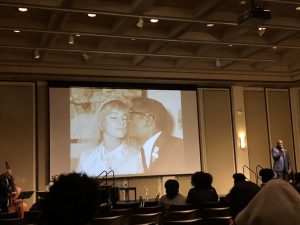The Langston Hughes Project event provided an opportunity for the community of the University of San Diego to experience African American culture in the form of jazz music and poetry as a way of celebrating Black History Month. Dr. Roy McCurdy of the University of Southern California offered his talents as a musician and his knowledge of the iconic poet, activist, and performer Langston Hughes’ work to bring to life Hughes’ Ask Your Mama: 12 Moods of Jazz. The presentation also utilized imagery and video as a backdrop to help the audience make a visual connection to the struggle and tradition associated with the African American culture. The performance tied in cultural aspects that transitioned from depicting the time of the Harlem Renaissance in the 1920s all the way to the 1960s where the struggle to end segregation made itself most prominent. The use of Hughes’ iconic words and the incorporation of jazz offered an immersive and educational experience to the audience through a historical and creative lens.
Langston Hughes utilized artistic forms, most notably poetry, to fight for the acceptance of African American culture in a time where there was great strife between races. He sought inspiration from his roots in the Harlem Renaissance in New York, which was a time of vast celebration of black culture and saw the rise of such icons as Josephine Baker and Zora Neale Hurston, the author of the novel we are reading in class, Barracoon. The Langston Hughes Project aims to honor Hughes as a central figure in solidifying and unifying African American culture and incorporated visual motifs that they feel best represents him and his purpose. The use of video collage represents different mediums coming together to make a statement. The focal point of the presentation, however, is the jazz music. According to the project, “Jazz was a cosmopolitan metaphor for Langston Hughes, a force for cultural convergence beyond the reach of words, or the limits of any one language.” The music, therefore, does not serve as purely an entertainment tool but rather a representation of the life and spirit of Hughes and inclusion of many cultures.
As stated above, Zora Neale Hurston was a notable figure alongside Langston Hughes during the Harlem Renaissance. Her novel, Barracoon, describes the story of Cudjo Lewis, who was the last known survivor of the Transatlantic Slave Trade. We can actually see a connection between Lewis’ experience and jazz music because the genre is said to have evolved from the calls and responses and chants of the enslaved peoples. Another important note is that within jazz music, one can see a fusion of African and European cultures, which can be witnessed in other areas such as the Gullah culture/language. This connection just adds to the significance of jazz music as a cultural staple that symbolizes hardship and the strength and community needed to combat such adversity. I believe that through his 12 Moods of Jazz, Langston Hughes was striving to demonstrate this importance to people of all races, and that is precisely what Dr. Roy McCurdy is doing through the Langston Hughes Project.
I felt that the Langston Hughes Project Event was very influential in presenting African American culture in an entertaining and informative way. Dr. McCurdy provided a brief introduction and a small trumpet solo, and proceeded to present the 12 Moods of Jazz. Such titles as “Cultural Exchange” and “Shades of Pigment” allowed the audience to recognize the role Hughes played as an activist against discrimination. The repetition of the phrase, “in the quarter of the negroes” in every mood made known the impact of racial restrictions in the everyday lives of African Americans. One section in “Cultural Exchange,” for example, addressed the dream of seeing African Americans in power and to see their votes be accounted for. Hughes dreamed for a world where Dr. Martin Luther King Jr. could be the governor of Georgia and where people of color could own white-pillared mansions. It is dreams such as these that the movement of gaining equality, one that Langston Hughes very much advocated for. By bringing this performance to life, Dr. McCurdy is educating the people of today of our history as a nation and the evolution of African American culture as a powerhouse that helps compose American culture.



